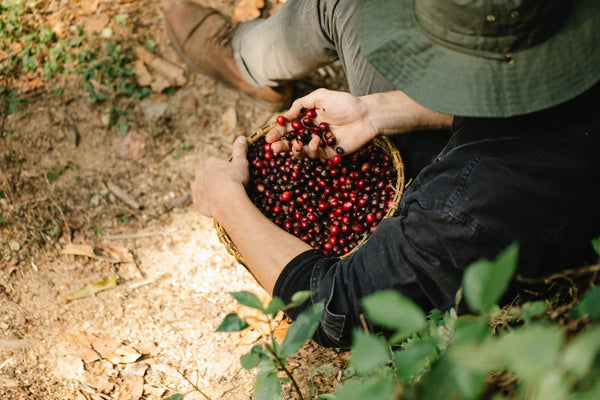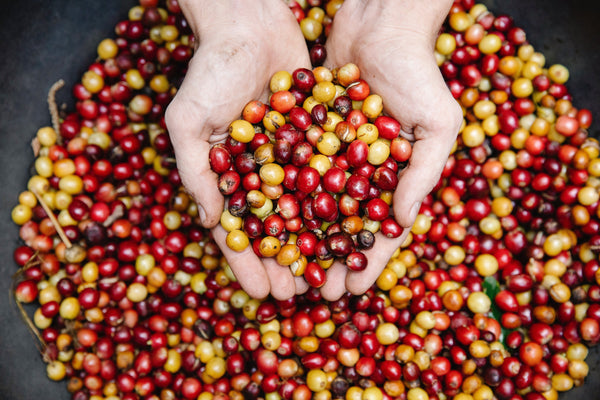
While most of us are used to the rich, robust aroma of roasted coffee beans, the world of green coffee beans is an unexplored territory for many. These unroasted coffee beans are the raw material of your morning brew. Roasting these beans at home allows you to unlock the hidden character and complex flavour profiles that can be tailored to your taste, making every sip a personalised experience.
What sets green coffee beans apart is the control they offer over the roasting process. You can select the exact heat and duration of roasting, enabling you to explore diverse flavour notes - from earthy and strong to sweet and mild. Making fresh roasted coffee is a delightful sensory exploration, as the beans transform from their raw green state to roasted brown.
But with so many different unroasted coffee bean types to choose from, how do you know what is right for you? In this blog, we’ll discuss some of the different aspects of growing and processing coffee beans that affect their flavour, as well as our top picks for green raw coffee beans in 2023.
The Journey of Coffee: Tracing the Origins of Green Coffee Beans
The coffee bean is a narrative of earth, climate, and cultivation. It's a story that significantly dictates the bean's final flavour and quality. With green coffee beans, this narrative starts in the growing location. Each country's coffee has different strengths and notes, offering a unique cup of coffee that mirrors its native land.
Ethiopia, hailed as the birthplace of coffee, offers green beans that are a true reflection of the country's vibrant and diverse landscape. Ethiopian coffee beans are cherished for their bright, fruity undertones that conjure images of the country's lush, high-altitude terrains. The distinct flavours can be attributed to the unique conditions in which the beans are grown, with fertile soil and high elevations.
Colombia, on the other hand, is renowned for its robust, full-bodied coffee beans. The secret behind the Colombian bean's flavour is the country's geography. Nestled between the Atlantic and Pacific Oceans, with the Andes mountains bisecting the country, Colombia boasts a number of microclimates. This geographical diversity allows coffee beans to flourish in a variety of conditions, leading to a wide spectrum of flavour profiles. Colombian beans, therefore, offer a consistently full-bodied coffee with rich, chocolatey notes.
Papua New Guinea, a lesser-known player in the coffee world, offers a unique experience for connoisseurs seeking something a little different. The beans from this region present a wild, fruity flavour profile, a testament to the island's fertile volcanic soil and tropical climate. The beans are cultivated in small farms and often processed using traditional methods, which further enhances their unique flavour.
Each region's distinctive climate, soil composition, and farming practices play a pivotal role in the final taste of the beans. Careful cultivation and processing techniques also contribute to the flavours that we cherish in our cup of coffee.

Altitude and Its Influence on Coffee Bean Flavour
The altitude at which coffee beans grow determines their flavour profile. This is due to the unique environmental conditions at different elevations which directly affect the development of the beans. Higher altitudes, with their cooler temperatures and reduced oxygen, cause coffee plants to grow more slowly. This growth rate allows beans to develop a more complex structure and richer flavour.
Grown above 1200 metres, high-altitude coffee beans are known for their bright acidity, a result of the beans' prolonged exposure to cold temperatures. This cooler environment slows down the beans' metabolic processes, leading to a higher concentration of sugars and organic acids. When these beans are roasted and brewed, the result is a coffee with a lively, tangy flavour.
In addition to heightened acidity, high-altitude beans are also noted for their heavier body. This is because the slower growth rate allows the beans to accumulate more nutrients and flavour compounds. When brewed, these beans produce a coffee that has a satisfying, full-bodied mouthfeel.
The most distinctive feature of high-altitude beans, however, is their pronounced flavours. The longer maturation period gives these beans time to develop an array of flavours. From fruity and floral notes of Ethiopian Yirgacheffe to the chocolate and nutty undertones of Colombian Excelso, high-altitude beans offer a range of intensities.
However, growing coffee at high altitudes does present some challenges. The harsh weather conditions, rugged terrain, and increased risk of disease make it a more labour-intensive and costly process. This, in turn, is often reflected on the price of high-altitude beans. Despite these challenges, farmers are committed to high-altitude cultivation due to the exceptional quality of coffee it produces.
The Art and Science of Coffee Bean Processing Techniques
Understanding the processing techniques of coffee beans is a crucial step in your journey as a home roaster. Let's delve deeper into the three main processing methods - the dry process, the wet or washed process, and the honey process.
The dry process, also known as natural processing, is the oldest method of coffee processing, involving leaving the coffee cherries to dry naturally in the sun. The fruit is regularly turned to ensure even drying, a process that can take up to four weeks. This method often results in beans with a full-bodied, fruity flavour. The dry processed beans can sometimes exhibit a wild, unpredictable flavour due to the extended contact with the fruity pulp. This can be a pro or a con, depending on your preference for adventurous flavours!
The washed or wet process, on the other hand, involves removing the pulp from the coffee cherry soon after harvesting, allowing the raw coffee beans to ferment in water. The fermentation breaks down the slimy layer of mucilage still present on the bean, which is then washed off, leaving the bean ready for drying. This method results in a cleaner, more acidic taste, offering a more consistent flavour. The downside is they require a large amount of water, which can be an environmental concern.
Then there's the honey process, a hybrid of the dry and wet processes. It involves removing only the outer skin of the cherry, leaving the mucilage intact and in contact with the fresh beans during the drying process. This results in sweet, complex flavours, but requires careful monitoring during drying to prevent spoilage, which can be a challenge for large-scale producers.
So, how do you choose the right processing method when buying green coffee beans? Consider your taste preferences. Do you enjoy a full-bodied, fruity coffee or prefer a cleaner, more acidic cup? Or perhaps you love the balance of sweet, complex flavours?
But it's not just about taste. Don't forget to consider the environmental impact of your choice. Wet processing uses a lot of water and can contribute to water pollution if not managed correctly. Meanwhile, dry processing requires less water but takes longer and can have unpredictable results.

Our Green Coffee Bean Selection of 2023
Navigating the huge range of green beans available can pose a challenge, even for seasoned coffee enthusiasts. Aided by in-depth research and careful tasting, we have curated a selection of the top green coffee beans in 2023. Each choice of quality bean has been evaluated based on its unique flavour profile, ideal roast level, and other distinguishing features.
Ethiopian Yirgacheffe
A coffee variety grown in the heights of southern Ethiopia, this bean carries a bright, fruity flavour that mingles with floral undertones. A medium to light roast best accentuates its characteristics, making it a top choice for those seeking a complex, aromatic cup.
Colombian Excelso
This single bean product, grown in the Medellin region of central Colombia, results in a complex cup. A medium to dark roast unveils its robust flavour, embodying a harmonious balance of acidity and body. This full-bodied taste, coupled with a hint of nuttiness, makes it a favourite among coffee lovers.
Hawkesbury
Hawkesbury is a blend that brings out the absolute best of its triple-origin composition. Papua New Guinean beans provide a subtle fruitiness; Brazilian beans offer sweetness, with nutty and dark chocolate notes. These two coffees combine with the strength and cocoa notes from a Ugandan coffee, delivering strength, flavour and intensity. As an espresso, it's a smooth and rich cup that stands out. In milk-based drinks, the blend has a delicious chocolatey, smooth finish.
Number 6
This product is a unique blend of several origins, namely Indonesia, PNG and Ethiopia. A medium roast brings out its chocolate and fruit notes with a smooth aftertaste. This blend won awards in 2017, 2018 and 2019 at Sydney Royal Show, making it a well-deserved popular choice.
PNG Organic
Sourced from the wild highlands of Papua New Guinea and grown at 6000 feet, this organic bean showcases the region's unique coffee profile. Once roasted, you can enjoy a light, slightly acidic and full-flavoured cup. There’s no need to be concerned about lingering pesticides due to the organic growing process.
House Blend 9
This 100% Arabica bean blend combines rounded, full-bodied Sulawesi beans with sweet aromatic characters of African & Central American origins. Medium to semi-dark roasting serves to accentuate overtones, evoking vanilla pods, red and blue berry notes and a clean caramel finish. The Kenyan beans provide a balanced, yet sharp acidity, with bold flavours and a smooth taste.
Fairtrade Ethiopian Harrar
This fair-trade bean from Eastern Ethiopia offers a full-bodied, wine-like flavour profile. A dark roast enhances its bold character and citrusy notes, a suitable choice for those seeking intensity.
PNG PSC X Women's Coffee
Made by women, this coffee from Papua New Guinea is more than just a bean. It embodies a story of empowerment and sustainability. A medium roast brings out its earthy, fruity notes, making it a flavourful and socially conscious choice!
Buy Green Coffee Beans in Australia
This guide promotes a deeper understanding of how the different aspects of coffee beans can transform your coffee experience. From its origins to processing methods and taste profiles, you can appreciate every cup.
At Green Bean Coffee, we pride ourselves on being a customer-focused and deeply knowledgeable coffee company, serving coffee connoisseurs across Australia.
We stock a wide selection of specialty coffees and coffee blends, so no matter what you like out of your coffee, we offer a delicious variety to keep you energised. Have any questions about the green or fresh roasted coffee beans we stock? Whether you need help with roasting methods or want a personalised recommendation, contact us today for a coffee and a chat.-
Prompt Delivery
-
Freshness Guaranteed
-
Personalised Service
-
Established in 2000

